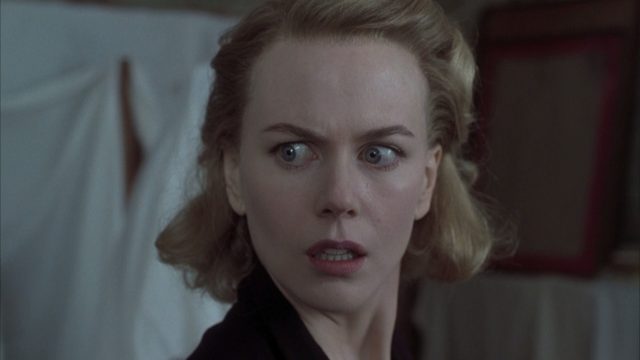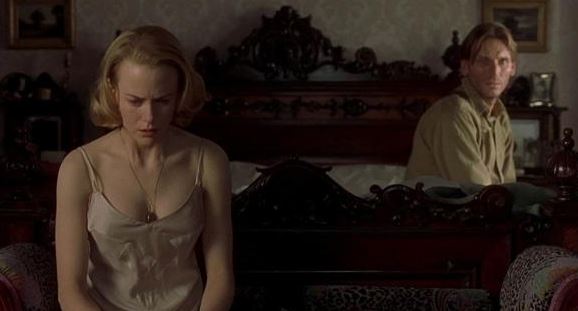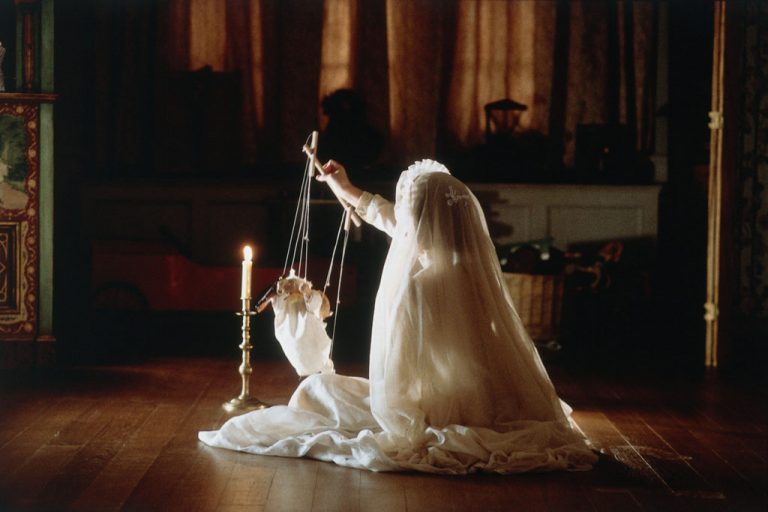What I admire most about The Others is that, like many a haunted house, it has an orderly surface that imperfectly conceals something messier, more troubled, and more ambiguous.
I love a good old-fashioned ghost story. The Others freely offers all the pleasures of its form. If you’re not under its spell, I’m sure it seems like a well-executed drinking game movie: immense manor home that swallows up its inhabitants (drink), psychologically fragile woman (drink) who is implicitly undersexed (drink), two young children (drink), a creepy older couple who knows more than they’re telling (drink), a mysterious thick fog, a why-the-hell-haven’t-you-torn-that-down-yet tree to be silhouetted against the gray sky, a hidden cemetery, religious obsession (drink, drink, drink)…
I’d maintain, first and foremost, that all of this is done very well. Amenábar casts it perfectly. Kidman, brittle and icy and deeply human, was born to be the breakable center of a Gothic; in contrast, the two children (Alakina Mann and James Bentley) give warmer and more motile performances. It’s crucial that they’re ordinary—Anne as the bright troublemaker, Nicholas as the vulnerable put-upon tagalong—because it implies a history we can’t see. Kidman’s Grace is a wire perpetually stretched to her breaking point, but in the low-key normalcy of her children, we see the evidence that she wasn’t always. It’s a nice, subtle bit of unobtrusive backstory, and you can see the same thing when her husband (Christopher Eccleston) returns home. Suddenly, she has support, companionship, adult company, romantic love, sexual ease, and she develops—heartbreakingly briefly—a kind of champagne giddiness and looseness. So she was different once, and the other characters know it.
It’s easy to see what changed her. Anne and Nicholas are adorable and the house is beautiful, but Grace’s world with them has narrowed to the point where the claustrophobia has become unbearable. (In case we missed it, the movie drives this home at one point by letting Kidman press her face up against some bars.) The children have an allergy that means any prolonged exposure to strong light will kill them, and Amenábar uses that brilliantly—“sunlit horror” is a recognizable strategy at this point, but The Others is one of only a few movies that uses the light as horror itself and makes a room drenched with sunshine into something menacing in and of itself. All of this means, too, that Grace is living most of her life in the dark—when she separates herself from the children, she still has to stay within earshot of them, so all her enjoyment of the light is temporary and conditional. As much as anything else, that’s what precipitates her break with reality: the servants all left in the night when, as she says, they knew she couldn’t leave the house. She’s becalmed.
An appropriate word, given one of my favorite lines in the film, Grace’s rationale for why they must always close the doors behind them: “The light must be contained as if it were water.” Here, everything is contained, but the ship is still sinking. She’s becoming more and more aggressive with her children, lecturing them about burning in the hell of limbo for telling lies and letting a punishment of Anne drag out for days. (I wouldn’t be surprised if The Babadook drew significantly from this—The Others is less explicit about its parallels with depression, but those parallels are still there.)
The structure and pacing are strong, with revelations coming fast and quick towards the end, one cascading after the other: Grace finds the Victorian photographs of the dead servants at the same time as the children find the graves, and the ensuing confrontation is what drives Anne and Nicholas upstairs to face the intruders and their séance, which is where it is finally revealed that Grace smothered her children before killing herself. More ghosts there, or ghosts within ghosts: Grace at one point tries to stifle Anne, and Anne Nicholas, by saying, “Stop breathing like that… stop breathing!” Grace also refers to the final danger of the light allergy as suffocation, in a particularly nice rewatch bonus.
So The Others enjoys its tropes, but it embeds them in well-developed characters who would plausibly be in these situations and experiencing these emotions. For the most part, it uses its scares in the same way. At one point, there’s a moment when Grace is whipping the sheets off furniture stored in a junk room, convinced that someone is hiding inside, and she tears the sheet off an eye-level mirror… and the fact of her own face in the mirror isn’t the scare, as it has been in numerous horror movies and also in my home late at night. Rather, the camera lingers on Grace’s white, frozen reflection as she sees the door behind her slowly close. The scare is grounded—there is someone here—and not cheap—you thought it was something, but it wasn’t something! Similarly, when Grace sees her daughter occupied by/occupying the body of a strange old woman, the dread is allowed to sink in. The horror isn’t just that liver-spotted hand with its walnut knuckles sticking out of the sleeve of a young girl’s christening dress, it’s the uncanny nature of Anne’s voice replying from that face, “Are you mad? I am your daughter!”
Which brings me, neatly enough, to where I think The Others goes above and beyond a great execution of familiar pleasures. Namely, the film offers a different kind of ambiguity than most psychological ghost stories. Ultimately, the question is not “are the ghosts real or is Grace going mad?” The answer, which is given and explicit, is more complicated than the question. Grace went mad. The ghosts are real. The ghosts are Grace and her children and her servants.
But as Mrs. Mills says, “There isn’t always an answer for everything.” Even when you have it, an answer doesn’t always mean resolution. Lydia, the servant girl, stopped talking for good when she realized she was dead and asked where she was and how she could be there.
The ghosts in The Others don’t seek to redress wrongs done to them. Instead, for the most part, they just keep on living, as it were, and the unnerving tragedy of them is how stuck they are. The children can now go into the sunlight, but they will always be children. The house is theirs, but the fog will always surround it. Recognition, not death, heals Grace’s psychological splintering. And, weirdest of all, the servants keep on being servants, raking leaves and making tea. It’s Grace and the children who end the movie chanting about their ownership of the house, not Bertha Mills and Mr. Tuttle.
This does feel like limbo, neither hell nor heaven, a place where the weaknesses of your body have gone but the weaknesses of your spirit are as persistent than ever. Eccleston is the best example of that, a dead soldier who is too mentally and emotionally wounded to ever return home even in death, who leaves them to go back to the front, back and endlessly back. “You’re so different,” Grace says when they’re finally reunited. His face is empty. “Sometimes I bleed,” he says.
There is no exit here, and there’s not even a clear second chance, or at least not one that Grace can clearly decide upon. Devastated, she recounts her almost unconscious murder of Anne and Nicholas and her aiming of the rifle at her forehead: “Then I heard your laughter in the bedroom. You were playing with the pillows as though nothing had happened. And I thought, the Lord, in His mercy, is giving me another chance.” But is it one? She was still mad all through it, still struggling. If it’s grace—if she’s Grace—it’s not what she thought it would be. She has to admit to her children, “I’m no wiser than you are.”
Subtly and enjoyably, all of this is accentuated by the piling-on of more and more ambiguous, liminal bits of scenery and storytelling. The house is in Jersey, an island in the Channel, neither here nor there; it’s a bit of England that was occupied during the war. The Victorian book of the dead is filled with photographs of corpses Grace first mistakes for people who are sleeping. There’s a beautiful, lingering shot of Grace in the window looking out at Tuttle, her reflection ghostly and transparent in the glass.
After this viewing, it occurred to me that the world of the dead and the world of the living would jar together even more uncomfortably when this house is inevitably turned into a museum, property of the National Trust, and that’s another blurring of the lines, where the private becomes the public. That goes nicely with the fact that even though the servants stay servants even in the afterlife, changes in class rumble underneath this whole movie. This was at the start of the time when you “couldn’t get the help,” when Britain was being reordered to pay for the costs of the war, which adds resonance to the nightly exit of Grace’s servants. In the 1940s, they could and would leave. When they died in the nineteenth century, they keep coming back.
But even the loyal-to-the-house Mrs. Mills and Mr. Tuttle see more clearly than Grace that the world is changing and that the power structure isn’t entirely intact. They don’t deny reality as Grace does, retreating into a world where everything is fine—“There are no intruders here,” she says at one point, with a glassy smile that shows Kidman’s brilliance in a single expression—and while they’re willing to bide their time, they’re also willing to stake their claim. As Mrs. Mills says, “There are going to be some big surprises. There are going to be… changes.” If that’s not entirely true within the house, it’s true in the world outside, where time will continue to move on.
Where Grace and her children will always be frozen in the window. At a troubling kind of peace.



